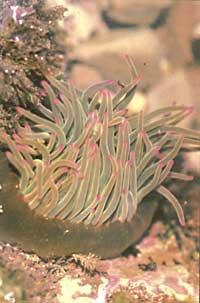Zumaia: natural areas of interest (III)

From this corner of Zumaia we would like to dedicate the last article to these natural spaces of interest. If you remember, when we started studying these natural spaces, we told you the most representative ecosystems of the coast: 1. Mouths of rivers, holm oaks and Cantabrian marshes (Bedua). 2. Dune systems of marsh and beach (Santiago de Compostela). 3. And on this occasion, we will try to study the cliffs and intertidal areas, where, like the rest, there are very rich, representative and curious ecosystems.
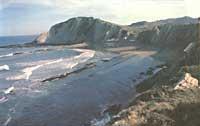
This unique corner of the coast that we are going to study is framed within a well-known geological structure, the coastal flysch. But you may think of the question: What is the flysch we have heard many times? It is easy to say, to rhythmically alternate limestones and soft materials (margas), as in our case, because of the different geological phenomena (sedimentary), forming the typical geological structure that is observed in the attached image.
Apparently, this geological structure was defined for the first time in the Alpe Mountains, although there this phenomenon occurred among other materials. All these formations are known as flysch.
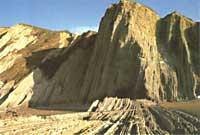
Undoubtedly, as we mentioned above, the landscape importance of these cliffs is evident, but do they have other characteristics?. On the one hand, when we talk about geology it seems that it is a very special and dry topic, and that it must be a subject of very specialized people. But it is not so, because to understand well the changes and phenomena that have occurred on our planet over the years, these areas become true museums and natural laboratories.
In our case, in the flysch of Zumaia are different materials, indicators of different geological times. If in the cove of Aitzuri, for example, we find white limestones of the Age 2 (of Cretaceous, about 70 million years ago), from the east new materials will appear. The rose-white materials appearing in our area are typical indicators of the end of Age 2.
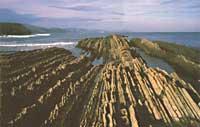
But if we observe how the layers formed with this material rise, how they bend, how they break (faults) or how they are transported, located and sediment, the area mentioned would become a true geological encyclopedia, and before a book in our schools what we often find so difficult to explain these phenomena, in it we would find it much easier and rich.
That is why the flysch of Zumaia is so well known, that from many places geologists come to carry out their research and tenths. Many times we do not correctly value what we have the natives in our hands, and it is time to give a deserving treatment to these ecological curiosities so scarce. For the benefit of all.

It is obvious that we are in the paradise of geologists, but we are not going to talk only about geology, but that this area has other interesting values. One of them is the vegetation. Remember in previous specimens (Elhuyar 33 and 35) the importance of this group in marshes and dune systems. For what is situated on slopes and cliffs is as important as the rest, that in order to live in this type of places has had to develop special treatments.
In addition, different areas appear on the cliffs. In some areas the force of the surf will occasionally influence. On other occasions, taking into account the orientation, the effect of the wind will be more violent and, of course, the state of the same cliff, that is, if it is eroded or not, if it is of great slope, if cracks appear or not, if they appear or not pisones.
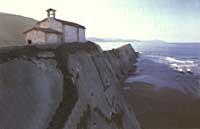
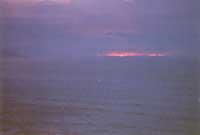
The native vegetation presents different adaptations (special systems of conservation in high salinity, strong radical apparatus, adaptation systems to be able to live in cracks...) that will allow to overcome the harsh conditions mentioned above.
But without extending too much to our area (cararrosa and quite eroded), especially in the soft sections (margatan) appear plants that fit these conditions. These include: Betizu horia ( Helichrysum stoechas), Itsas mihilua ( Crithmum maritimum), Zauri-belarra ( Anthyllis vulneraria), Itsas plantaina ( Plantago maritima) and ( Stachys ocymastrum).
It should be noted, although it is not a typical species of the cliffs, the rare orsiniana Veronica in the north, which is in our area, for its uniqueness. On the other hand, the effect of the wind is usually very violent, so the presence of trees is quite difficult. However, occasionally arts are seen, obtaining very special shapes thanks to the action of the wind. It also highlights a bush, the carrasquillo ( Rhamnus alaternus). Quite common on the sea slopes. As we move away from the cliffs in general, the heath appears, which presents two typical species: the burusoila eel ("Erica vagans") and the common basket ("Genista hispanica subsp occidentalis").

As a culmination of this area, we must mention the intertidal spaces, authentic museums and natural laboratories. These areas have been exploited for some time, with numerous species: quisquillas, octopus, ten, magurios, algae, lapas...
In these ecosystems, often (especially in summer), children acquire many things with their parents, generating different consequences. However, these spaces are very suitable for didactic activities. For example, the importance and convenience of using these ecosystems should appear in the natural programming of our schools. But, of course, the teaching should not be accused of everything, because it will be in vain while other people and entities do not put the means to do so.

We have only mentioned some living things, but in a small well we can find different algae from the botanical point of view, animal shells (sea acorns, quisquillas, different crabs...), mollusks (octopus, mussels, lapas and magurios), echinoderms (star and sea urchin), cnidarios (actinis and marine fish).
View
we can with all this material carry out a didactic and ecological study of this ecosystem (relationships between all living beings, food chains, murals, etc.) would not be difficult for us; of course, having minimal respect for these places of residence.
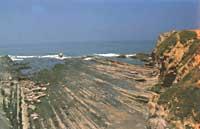
On the other hand, with the help of some of the prismatic areas mentioned, it is also an ideal place for the observation of seabirds (seagulls, ditches, cormorants...), different limicolos (marine mica, revolutionary pedrisco,...) and, in general, poultry.
We wanted to finish with the flight of Cormorán the study of these interesting natural spaces of the area of Zumaia (remember those published in the numbers 33 and 35 of Elhuyar). We, above all, emphasize that in the planning presented in its day by the Provincial Council, the environment of Bedua was unprotected, and in these lines we pointed out the need and reasons to protect it recognizing that it is a very interesting and recoverable ecosystem.
On the other hand, there is the fact that the minimalist critics who want to use may or may not repair the state of these ecosystems. However, since our politicians have already started the campaign, the conservation and ecology of the environment will once again extol. They act according to what they say. We will see.
